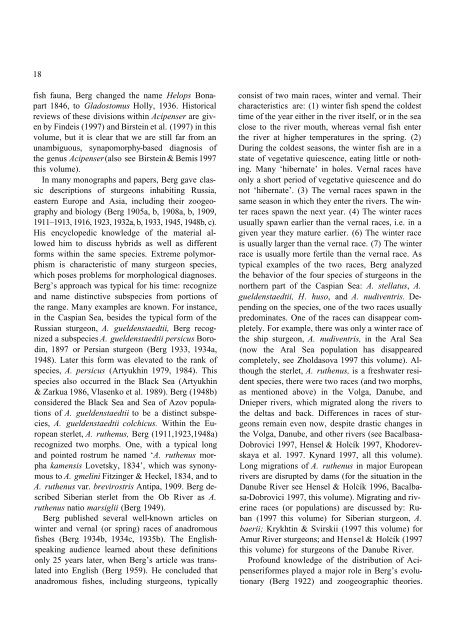Sturgeon biodiversity and conservation
Sturgeon biodiversity and conservation
Sturgeon biodiversity and conservation
You also want an ePaper? Increase the reach of your titles
YUMPU automatically turns print PDFs into web optimized ePapers that Google loves.
18<br />
fish fauna, Berg changed the name Helops Bonapart<br />
1846, to Gladostomus Holly, 1936. Historical<br />
reviews of these divisions within Acipenser are given<br />
by Findeis (1997) <strong>and</strong> Birstein et al. (1997) in this<br />
volume, but it is clear that we are still far from an<br />
unambiguous, synapomorphy-based diagnosis of<br />
the genus Acipenser(also see Birstein & Bemis 1997<br />
this volume).<br />
In many monographs <strong>and</strong> papers, Berg gave classic<br />
descriptions of sturgeons inhabiting Russia,<br />
eastern Europe <strong>and</strong> Asia, including their zoogeography<br />
<strong>and</strong> biology (Berg 1905a, b, 1908a, b, 1909,<br />
1911–1913, 1916, 1923, 1932a, b, 1933, 1945, 1948b, c).<br />
His encyclopedic knowledge of the material allowed<br />
him to discuss hybrids as well as different<br />
forms within the same species. Extreme polymorphism<br />
is characteristic of many sturgeon species,<br />
which poses problems for morphological diagnoses.<br />
Berg’s approach was typical for his time: recognize<br />
<strong>and</strong> name distinctive subspecies from portions of<br />
the range. Many examples are known. For instance,<br />
in the Caspian Sea, besides the typical form of the<br />
Russian sturgeon, A. gueldenstaedtii, Berg recognized<br />
a subspecies A. gueldenstaedtii persicus Borodin,<br />
1897 or Persian sturgeon (Berg 1933, 1934a,<br />
1948). Later this form was elevated to the rank of<br />
species, A. persicus (Artyukhin 1979, 1984). This<br />
species also occurred in the Black Sea (Artyukhin<br />
& Zarkua 1986, Vlasenko et al. 1989). Berg (1948b)<br />
considered the Black Sea <strong>and</strong> Sea of Azov populations<br />
of A. gueldenstaedtii to be a distinct subspecies,<br />
A. gueldenstaedtii colchicus. Within the European<br />
sterlet, A. ruthenus, Berg (1911,1923,1948a)<br />
recognized two morphs. One, with a typical long<br />
<strong>and</strong> pointed rostrum he named ‘A. ruthenus morpha<br />
kamensis Lovetsky, 1834’, which was synonymous<br />
to A. gmelini Fitzinger & Heckel, 1834, <strong>and</strong> to<br />
A. ruthenus var. brevirostris Antipa, 1909. Berg described<br />
Siberian sterlet from the Ob River as A.<br />
ruthenus natio marsiglii (Berg 1949).<br />
Berg published several well-known articles on<br />
winter <strong>and</strong> vernal (or spring) races of anadromous<br />
fishes (Berg 1934b, 1934c, 1935b). The Englishspeaking<br />
audience learned about these definitions<br />
only 25 years later, when Berg’s article was translated<br />
into English (Berg 1959). He concluded that<br />
anadromous fishes, including sturgeons, typically<br />
consist of two main races, winter <strong>and</strong> vernal. Their<br />
characteristics are: (1) winter fish spend the coldest<br />
time of the year either in the river itself, or in the sea<br />
close to the river mouth, whereas vernal fish enter<br />
the river at higher temperatures in the spring. (2)<br />
During the coldest seasons, the winter fish are in a<br />
state of vegetative quiescence, eating little or nothing.<br />
Many ‘hibernate’ in holes. Vernal races have<br />
only a short period of vegetative quiescence <strong>and</strong> do<br />
not ‘hibernate’. (3) The vernal races spawn in the<br />
same season in which they enter the rivers. The winter<br />
races spawn the next year. (4) The winter races<br />
usually spawn earlier than the vernal races, i.e. in a<br />
given year they mature earlier. (6) The winter race<br />
is usually larger than the vernal race. (7) The winter<br />
race is usually more fertile than the vernal race. As<br />
typical examples of the two races, Berg analyzed<br />
the behavior of the four species of sturgeons in the<br />
northern part of the Caspian Sea: A. stellatus, A.<br />
gueldenstaedtii, H. huso, <strong>and</strong> A. nudiventris. Depending<br />
on the species, one of the two races usually<br />
predominates. One of the races can disappear completely.<br />
For example, there was only a winter race of<br />
the ship sturgeon, A. nudiventris, in the Aral Sea<br />
(now the Aral Sea population has disappeared<br />
completely, see Zholdasova 1997 this volume). Although<br />
the sterlet, A. ruthenus, is a freshwater resident<br />
species, there were two races (<strong>and</strong> two morphs,<br />
as mentioned above) in the Volga, Danube, <strong>and</strong><br />
Dnieper rivers, which migrated along the rivers to<br />
the deltas <strong>and</strong> back. Differences in races of sturgeons<br />
remain even now, despite drastic changes in<br />
the Volga, Danube, <strong>and</strong> other rivers (see Bacalbasa-<br />
∨<br />
Dobrovici 1997, Hensel & Holcík 1997, Khodorevskaya<br />
et al. 1997. Kynard 1997, all this volume).<br />
Long migrations of A. ruthenus in major European<br />
rivers are disrupted by dams (for the situation in the<br />
∨<br />
Danube River see Hensel & Holcík 1996, Bacalbasa-Dobrovici<br />
1997, this volume). Migrating <strong>and</strong> riverine<br />
races (or populations) are discussed by: Ruban<br />
(1997 this volume) for Siberian sturgeon, A.<br />
baerii; Krykhtin & Svirskii (1997 this volume) for<br />
Amur River sturgeons; <strong>and</strong> Hensel& Holcík (1997<br />
∨<br />
this volume) for sturgeons of the Danube River.<br />
Profound knowledge of the distribution of Acipenseriformes<br />
played a major role in Berg’s evolutionary<br />
(Berg 1922) <strong>and</strong> zoogeographic theories.
















